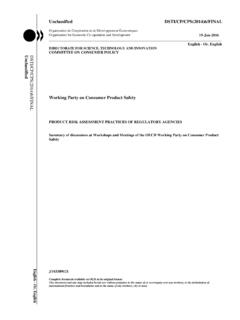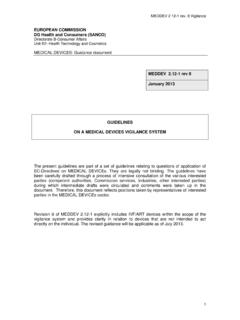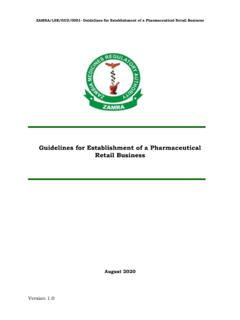Transcription of FOOD STORAGE GUIDELINES - foodbanksbc.org
1 FOOD STORAGE GUIDELINES Explanation of Food Labeling and product Dating Shelf Stable Foods Bakery Products Fresh Produce Frozen Foods Refrigerated Foods Simple Food STORAGE GUIDELINES USDA - FOOD LABELING AND product DATING "Sell by Feb 14" is a type of information you might find on a meat or poultry product . Are dates required on food products? Does it mean the product will be unsafe to use after that date? Here is some background information which answers these and other questions about product dating. What is Dating? "Open Dating" (use of a calendar date as opposed to a code) on a food product is a date stamped on a product 's package to help the store determine how long to display the product for sale. It can also help the purchaser to know the time limit to purchase or use the product at its best quality.
2 It is not a safety date. After the date passes, while not of best quality, the product should still be safe if handled properly and kept at 40 F or below for the recommended STORAGE times listed on the chart (see below). If product has a "use-by" date, follow that date. If product has a "sell-by" date or no date, cook or freeze the product by the times on the chart. Is Dating Required by Federal Law? Except for infant formula and some baby food (see below), product dating is not generally required by Federal regulations. However, if a calendar date is used, it must express both the month and day of the month (and the year, in the case of shelf-stable and frozen products). If a calendar date is shown, immediately adjacent to the date must be a phrase explaining the meaning of that date such as "sell-by" or "use before.
3 " There is no uniform or universally accepted system used for food dating in the United States. Although dating of some foods is required by more than 20 states, there are areas of the country where much of the food supply has some type of open date and other areas where almost no food is dated. What Types of Food Are Dated? Open dating is found primarily on perishable foods such as meat, poultry, eggs and dairy products. "Closed" or "coded" dating might appear on shelf-stable products such as cans and boxes of food. Types of Dates A "Sell-By" date tells the store how long to display the product for sale. You should buy the product before the date expires. A "Best if Used By (or Before)" date is recommended for best flavor or quality. It is not a purchase or safety date.
4 A "Use-By" date is the last date recommended for the use of the product while at peak quality. The date has been determined by the manufacturer of the product . "Closed or coded dates" are packing numbers for use by the manufacturer. Safety After Date Expires Except for "use-by" dates, product dates don't always refer to home STORAGE and use after purchase. "Use-by" dates usually refer to best quality and are not safety dates. But even if the date expires during home STORAGE , a product should be safe, wholesome and of good quality if handled properly and kept at 40 F or below. See the accompanying refrigerator charts for STORAGE times of dated products. If product has a "use-by" date, follow that date. If product has a "sell-by" date or no date, cook or freeze the product by the times on the chart.
5 Foods can develop an off odor, flavor or appearance due to spoilage bacteria. If a food has developed such characteristics, you should not use it for quality reasons. If foods are mishandled, however, foodborne bacteria can grow and cause foodborne illness -- before or after the date on the package. For example, if hot dogs are taken to a picnic and left out several hours, they wouldn't be safe if used thereafter, even if the date hasn't expired. Other examples of potential mishandling are products that have been: defrosted at room temperature more than two hours; cross contaminated; or handled by people who don't use proper sanitary practices. Make sure to follow the handling and preparation instructions on the label to ensure top quality and safety.
6 Dating Formula & Baby Food Federal regulations require a "use-by" date on the product label of infant formula and the varieties of baby food under FDA inspection. If consumed by that date, the formula or food must contain not less than the quantity of each nutrient as described on the label. Formula must maintain an acceptable quality to pass through an ordinary bottle nipple. If stored too long, formula can separate and clog the nipple. Dating of baby food is for quality as well as for nutrient retention. Just as you might not want to eat stale potato chips, you wouldn't want to feed your baby meat or other foods that have an off flavor or texture. The "use-by" date is selected by the manufacturer, packer or distributor of the product on the basis of product analysis throughout its shelf life; tests; or other information.
7 It is also based on the conditions of handling, STORAGE , preparation and use printed on the label. Do not buy or use baby formula or baby food after its "use-by" date. What Do Can Codes Mean? Cans must exhibit a packing code to enable tracking of the product in interstate commerce. This enables manufacturers to rotate their stock as well as to locate their products in the event of a recall . These codes, which appear as a series of letters and/or numbers, might refer to the date or time of manufacture. They aren't meant for the consumer to interpret as "use-by" dates. There is no book which tells how to translate the codes into dates. Cans may also display "open" or calendar dates. Usually these are "best if used by" dates for peak quality. In general, high-acid canned foods such as tomatoes, grapefruit and pineapple can be stored on the shelf 12 to 18 months; low-acid canned foods such as meat, poultry, fish and most vegetables will keep 2 to 5 years if the can remains in good condition and has been stored in a cool, clean, dry place.
8 Dates on Egg Cartons Use of either a "Sell-By" or "Expiration" (EXP) date is not federally required, but may be State required, as defined by the egg laws in the State where the eggs are marketed. Some State egg laws do not allow the use of a "sell-by" date. Many eggs reach stores only a few days after the hen lays them. Egg cartons with the USDA grade shield on them must display the "pack date" (the day that the eggs were washed, graded, and placed in the carton). The number is a three-digit code that represents the consecutive day of the year (the day that the eggs were washed, graded, and placed in the carton). The number is a three-digit code that represents the consecutive day of the year (the "Julian Date") starting with January 1 as 001 and ending with December 31 as 365.
9 When a "sell-by" date appears on a carton bearing the USDA grade shield, the code date may not exceed 45 days from the date of pack. Always purchase eggs before the "Sell-By" or "EXP" date on the carton. After the eggs reach home, refrigerate the eggs in their original carton and place them in the coldest part of the refrigerator, not in the door. For best quality, use eggs within 3 to 5 weeks of the date you purchase them. The "sell-by" date will usually expire during that length of time, but the eggs are perfectly safe to use. UPC or Bar Codes Universal product Codes appear on packages as black lines of varying widths above a series of numbers. They are not required by regulation but manufacturers print them on most product labels because scanners at supermarkets can "read" them quickly to record the price at checkout.
10 Bar codes are used by stores and manufacturers for inventory purposes and marketing information. When read by a computer, they can reveal such specific information as the manufacturer's name, product name, size of product and price. The numbers are not used to identify recalled products. STORAGE Times Since product dates aren't a guide for safe use of a product , how long can the consumer store the food and still use it at top quality? Follow these tips: Purchase the product before the date expires. If perishable, take the food home immediately after purchase and refrigerate it promptly. Freeze it if you can't use it within times recommended on chart. Once a perishable product is frozen, it doesn't matter if the date expires because foods kept frozen continuously are safe indefinitely.



